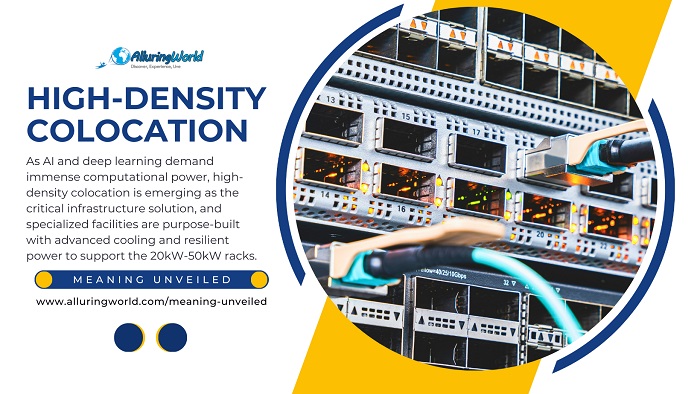As artificial intelligence (AI) and machine learning (ML) continue their rapid evolution and transformation of industries worldwide, the prerequisite for immense, resilient computational power has skyrocketed. High-density colocation is emerging as a critical, purpose-built infrastructure solution, enabling businesses to meet the extreme power and cooling requirements necessary for the intense, demanding workloads associated with modern AI, deep learning, and GPU computing. This specialized approach to data center infrastructure is rapidly becoming the foundation upon which the next generation of data-intensive technologies will be built.
The Rise of High-Density AI and ML Workloads:
AI and ML applications inherently require significant processing capabilities. These workloads often involve iterating on complex algorithms, training large neural networks, and processing vast, multi-structured datasets, such as those used in natural language processing, computer vision, and predictive analytics.
These demanding tasks necessitate not only high-performance computing resources – specifically Graphical Processing Units (GPUs) and advanced CPUs – but, more critically, the ability to manage the resultant heat dissipation and power consumption efficiently and reliably. A single rack housing cutting-edge AI equipment can easily consume 20kW to over 50kW of power, far exceeding the typical 5kW to 10kW capacity of a standard, legacy data center rack.
Traditional or lower-density data centers are often fundamentally incapable of supporting the energy, cooling, and space density needs of advanced AI workloads. Their power distribution systems, cooling infrastructure (like standard Computer Room Air Conditioning or CRAC units), and floor loading capacities were not designed for this level of concentration. This architectural limitation makes high-density colocation not merely a convenience, but a compelling and often necessary alternative for companies committed to large-scale AI deployment.
Defining High-Density Colocation:
High-density colocation facilities provide an environment specifically engineered to handle power draws significantly above the industry average. These facilities allow businesses to house their owned or leased servers, storage, and networking equipment in a shared physical space that offers superior infrastructure capabilities.
Key infrastructural elements of a high-density environment include:
- Enhanced Power Distribution: Colocation providers utilize robust power delivery systems, often featuring redundant power feeds, high-capacity uninterruptible power supplies (UPS), and high-amperage rack power distribution units (PDUs) to reliably deliver the substantial power required for GPU-accelerated servers.
- Advanced Cooling Systems: To combat the intense heat generated by high-density racks, these facilities employ specialized cooling technologies. This often includes liquid cooling solutions, such as direct-to-chip cooling, rear-door heat exchangers, or immersion cooling, which are far more efficient at removing concentrated heat than traditional air cooling. The ability to maintain precise and optimal operating temperatures is crucial for maximizing the performance and longevity of expensive AI hardware.
- Scalable and Modular Resources: High-density colocation is designed with modularity in mind. This allows organizations to procure and deploy space, power, and cooling resources incrementally, scaling their capacity as their AI model complexity and dataset size grow, without the massive upfront capital expenditures of building a dedicated facility.
This setup is particularly advantageous for companies leveraging modern GPUs, which are essential for AI computations due to their architecture that supports massive parallel processing, making them orders of magnitude faster for tasks like neural network training than traditional CPUs.
Strategic Benefits of Utilizing High-Density Colocation:
The specialized infrastructure of high-density colocation offers several strategic advantages for organizations pursuing cutting-edge AI initiatives:
- Optimal Scalability: High-density colocation allows organizations to easily scale their operations to match the explosive growth of AI applications. As computational needs rise, colocation facilities can quickly adapt to this growth, providing additional power, cooling capacity, and physical space through their pre-engineered infrastructure. This agility removes a major constraint often faced by in-house data centers.
- Significant Cost Efficiency: By migrating AI workloads to a colocation environment, companies can significantly reduce the Total Cost of Ownership (TCO) compared to building and maintaining their own high-density-capable data centers. The shared resource model (power, cooling, physical security, connectivity) optimizes space and power usage, ensuring that businesses only pay for the high-density capacity they consume—an operational expense (OpEx) model rather than a capital expense (CapEx) burden.
- Enhanced and Sustained Performance: With infrastructure specifically built for high thermal loads, high-density colocation providers can ensure optimal, sustained performance for power-hungry AI workloads. The deployment of advanced cooling technologies prevents equipment from reaching thermal limits, thereby eliminating the need for servers to throttle performance and maximizing uptime for continuous model training and inference.
- Access to Specialized Expertise: Leading colocation providers often employ teams of experts specializing in data center management, power engineering, and advanced cooling modalities. For businesses focusing on their core AI development, this access to specialized, 24/7 operational knowledge can be invaluable, offloading the complexity and risk associated with managing high-density environments. This allows internal teams to focus on innovation rather than infrastructure maintenance.
The Foundational Role of Colocation in the AI Era:
The proliferation of AI and ML is having a profound and lasting influence on data center design and operation. It is driving an urgent need for facilities that can not only support but also sustainably house these power-dense, mission-critical technologies.
High-density colocation meets this challenge head-on. By providing a pre-built, resilient, and highly adaptable environment, it ensures that data center infrastructure remains agile and efficient in the face of ever-increasing AI demands. Investing in robust colocation solutions is no longer a luxury but a foundational element for organizations seeking to harness the immense potential of AI.
Conclusion:
In conclusion, high-density colocation is not just a passing technology trend; it is the foundational infrastructure powering the future of AI and machine learning. By providing the necessary, robust infrastructure, specialized cooling, resilient power, and unparalleled scalability, it enables companies to optimize performance, control costs, and ultimately thrive in an increasingly data-driven, computationally-intensive world.

